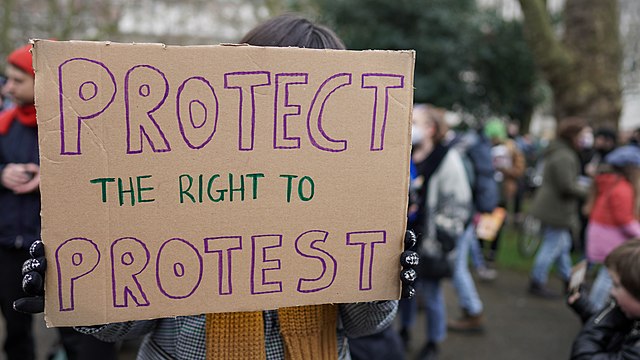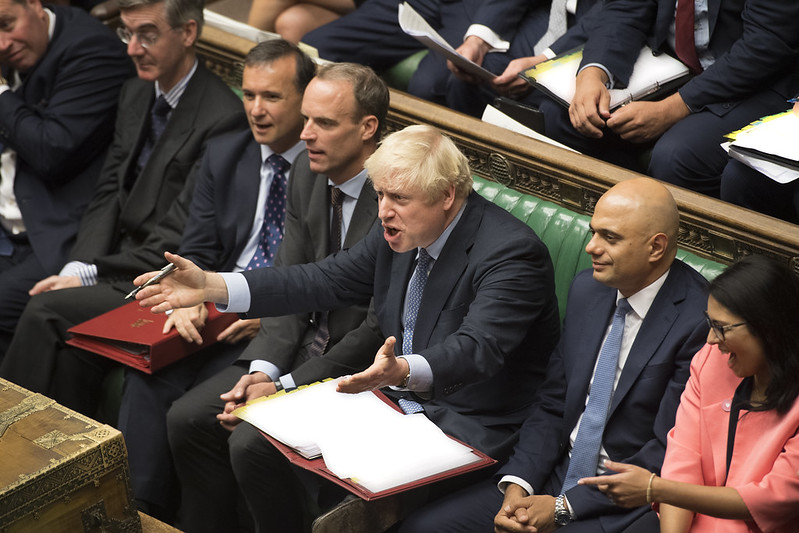Proponents of a ban on ‘extreme pornography’ are looking increasingly desperate in their attempts to push their plan through Parliament, writes Julian Petley
Faced with a rising tide of opposition in the Lords, the government dropped yet more parts of its Criminal Justice and Immigration Bill on 27 February, including a crackdown on prostitution and a proposal which would have stopped the appeal court quashing convictions on a technicality in cases where there was ‘no reasonable doubt’ about a defendant’s guilt. However, the highly controversial clauses which will make it an offence even to possess certain kinds of ill-defined pornography remain firmly in place, in spite of the grave doubts about them now being raised — albeit belatedly — in Parliament.
For example, in its legislative scrutiny of the bill, the Joint Committee on Human Rights noted that the government had already made it clear that it felt that the seriousness of the proposed offences justified interference with Articles 8 and 10 of the European Convention on Human Rights, which concern, respectively, an individual’s right to private life and their right freely to receive and impart information (including information which is offensive or unpalatable). However, the committee was concerned whether ‘the definition of the new offence is sufficiently precise and foreseeable’ to satisfy the requirement that interferences with these rights are ‘in accordance with the law’. Thus it asked the minister to explain how an individual user of pornography would be able to know whether their possession of a particular image would constitute a criminal offence. In reply, he stated that the government believed that the user of such material would have ‘no difficulty in recognising pornography’ and that extreme images would be “recognisable” or “easily recognisable”. However, the committee remained unhappy about ‘the vagueness of the definition of the offence’, noting that ‘an assessment of whether an image is or is not ‘extreme’ is inherently subjective and may not, in every case, be, as the government suggests, “recognisable” or “easily recognisable”. This means that individuals seeking to regulate their conduct in accordance with the criminal law cannot be certain that they will not be committing a criminal offence by having certain images in their possession.’ They concluded: ‘We look forward to the government bringing forward an amendment to make the scope of the new offence more precise.’
Similar points were raised when the bill was debated in the Lords on 22 January. As a consequence, the government introduced a series of amendments on 8 February. A pornographic image is now defined as one which ‘is of such a nature that it must reasonably be assumed to have been produced solely for or principally for the purposes of sexual arousal’ and an ‘extreme image’ is defined as one which ‘is grossly offensive, disgusting or otherwise of an obscene character’ and ‘if it portrays, in an explicit and realistic way, any of the following —
(a) an act which threatens a person’s life,
(b) an act which results in or is likely to result in serious injury to a person’s anus, breasts or genitals,
(c) an act which involves sexual interference with a human corpse,
(d) a person performing an act of intercourse or oral sex with an animal (whether dead or alive),
and a reasonable person looking at the image would think that any such person or animal was real.’
These amendments were debated in the Lords on 3 March, and it was almost universally agreed that they served only to widen the scope of the clause and to make it more vague still. Thus, for example, Baroness Falkner cautioned about ‘introducing legislation which is too broadly drafted and very wide in scope and which encompasses … some element of thought crime’. Accusing the government of introducing ‘a much more subjective standard’, she continued: ‘The problem here lies in defining what is offensive and disgusting, which is naturally subjective. It is dangerous to attempt to comment in criminal law on where the boundaries of taste lie.’
Similarly, Lord Maclennan argued that ‘the definition is far too sweeping’ and that ‘the provision is just badly thought out. The whole thing needs to be taken back and worked on again. We will be legislating in haste if we allow this to pass; and he could regret it very much at leisure’, whilst Lord Wallace noted that ‘if we are indeed about to create a statutory offence with the potential for a serious term of imprisonment, we really need something that stands up to scrutiny much more than the terms of this clause’.
Although virtually no one spoke in favour of the proposals, Lord Hunt, for the government, was not to be moved. However, the fact that he was reduced largely to repeating by now extremely tired, over-familiar and discredited arguments smacked of considerable desperation. So, for example:
• ‘It is not, and never has been, our intention to capture material that would not already be subject to prosecution under the Obscene Publications Act 1959 if it were published in this country.’ There is a yawning chasm of difference between actually producing and/or distributing material which might fall foul of the OPA’s ‘deprave and corrupt’ test and merely possessing material which might be illegal under the Criminal Justice Bill’s vague, subjective and unworkable definitions of ‘extreme pornography’.
• ‘A recent rapid evidence assessment study, published jointly by the Ministry of Justice and the Department of Health, indicates that such material may have harmful effects on some people.’ This highly partisan document has been produced by closed minds for closed minds simply and solely for the purposes of justifying the bill’s anti-porn measures.
• The ‘explicit and realistic’ definition is necessary, otherwise it ‘would make it necessary for the prosecution to prove that the events being depicted had actually taken place—that a person’s life had actually been taken or that a life-threatening injury had been inflicted; in short, that a very serious crime had taken place. That would place an insurmountable burden on the prosecution, particularly when much material is produced abroad’. In other words, in spite of the government’s much vaunted commitment to fighting global crime with our international partners, the police and prosecuting authorities just can’t be bothered to track down the perpetrators of real crimes when it’s so much easier to harass in their own homes what they doubtless regard as the local perverts. This really is quite breathtakingly feeble.
• The anti-porn measures were ‘consulted on widely through the consultation held on the case for a new offence in 2005, which was followed by publication of a summary of the responses to that consultation and then the Government’s conclusions in 2006.’ Yes, and the vast majority of sane and reasoned responses counselled against them in the strongest possible terms.
• ‘This is not a debate about the rights and wrongs of pornography in the round but about the wide availability of extreme or violent pornography.’ One simply does not set out to make something illegal unless one considers it wrong in some way, and it is by now perfectly clear to everyone, apart from Lord Hunt, apparently, that this measure will criminalise the possession of pornography way beyond the confines of the ‘extreme or violent’.
• ‘It seems plain common sense that this awful stuff must have a negative, adverse impact on some of the people viewing it.’ When politicians attempt to justify legislation by appealing to ‘common sense’ you know that they’ve got no reasoned arguments left.
I understand that, not altogether surprisingly, there are those in government who would now dearly like to rid themselves of this ill thought-out and thoroughly oppressive measure. So what’s stopping them?
The answer is that they don’t want to be painted as soft on porn. Interestingly enough, the normally censorious and illiberal press has stayed unusually quiet on the anti-porn proposals, although it’s not hard to guess why. Firstly, English newspapers may be no strangers to hypocrisy, but even they realise that they cannot daily attack the ‘nanny state’s’ alleged assaults on individual liberty whilst at the same time supporting a measure which indeed puts nanny firmly into jackboots. And secondly, a significant proportion of some of these papers’ readers will themselves be consumers of porn and thus could easily, if unwittingly, find themselves in possession of pornography deemed ‘extreme’ according to the vague, catch-all definitions contained in the bill.
However, the government also has to contend with the ceaseless efforts of two of its own MPs, Martin Salter and David Lepper, to ensure that whatever else is dropped from this increasingly slim bill, the anti-porn proposals will remain. As I pointed out in my last commentary on the bill, these measures have their origin in the murder in 2003 of Jane Longhurst by Graham Coutts, who visited websites that contained pornography featuring violence. As a consequence, Longhurst’s mother supported by Salter, Lepper and the Daily Mail, started the Jane Longhurst Campaign Against Violent Internet Pornography. This resulted in a petition which received 50,000 signatures. This in turn resulted in the Home Office publishing in August 2005 its Consultation on the Possession of Extreme Pornographic Material, and the rest is history.
However, the extent to which the petition supports the anti-porn measures contained in the bill is, in fact, nothing like as clear cut as Salter and Lepper habitually claim. For example in a press release on 27 June 2007 headed ‘Salter Welcomes Criminal Justice Bill’, the MP stated that, in the wake of the murder of Jane Longhurst, ‘a national petition was launched calling for extreme pornographic images featuring rape, torture and necrophilia to be treated under the law the same way as child pornography’. But this is clearly not what the petition seeks to ban, which is ‘Internet sites promoting violence against women in the name of sexual gratification’. And that word ‘promoting’ should ring exactly the same loud alarm bells as it did when used in the notorious Section 28. To repeat a point endlessly made by those — including many Labour MPs — who opposed that particularly unpleasant piece of censorship: to show or to represent is by no means necessarily the same thing as to promote. Furthermore, the Criminal Justice Bill is not concerned only with images downloaded from the Internet but with any image of any kind however it was acquired.
Amnesty International supported the original campaign, and Salter and Lepper have frequently implied that it supports the measures put forward in the Criminal Justice Bill. However, this has provoked Amnesty into issuing a clarification which amounts to a pretty forthright denial. This states, inter alia, that: ‘Amnesty International UK supported Liz Longhurst’s campaign through our affiliation to the End Violence Against Women campaign. Our involvement was not in any way related to the pornographic content of the crime but purely to the violent murder of the victim … Amnesty International-UK does not take a position on pornography.’
However, nothing daunted, David Lepper in the Commons debate on the bill on 8 October 2007, stated that ‘the provisions before us tonight do not go as far as many of us want’ and promised ‘a further stage of the campaign’. One wonders what on earth is coming next, but whatever it is, let’s hope that the campaign in support of it is waged with a little more honesty (and a little less moral grandstanding) than the current one.






